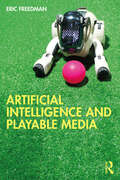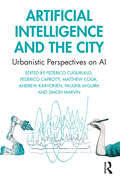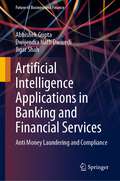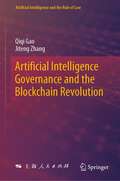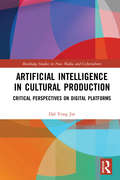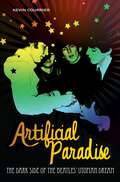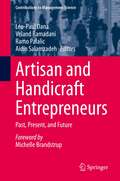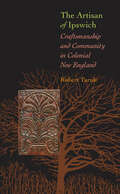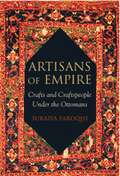- Table View
- List View
Artificial Intelligence and Playable Media
by Eric FreedmanThis book introduces readers to artificial intelligence (AI) through the lens of playable media and explores the impact of such software on everyday life. From video games to robotic companions to digital twins, artificial intelligence drives large sectors of the culture industry where play, media and machine learning coexist. This book illustrates how playable media contribute to our sense of self, while also harnessing our data, tightening our bonds with computation and realigning play with the demands of network logic. Author Eric Freedman examines a number of popular media forms - from the Sony AIBO robotic dog, video game developer Naughty Dog’s Uncharted and The Last of Us franchises, to Peloton’s connected fitness equipment - to lay bare the computational processes that undergird playable media, and addresses the social, cultural, technological and economic forces that continue to shape user-centered experience and design. The case studies are drawn from a number of related research fields, including science and technology studies, media studies and software studies. This book is ideal for media studies students, scholars and practitioners interested in understanding how applied artificial intelligence works in popular, public and visual culture.
Artificial Intelligence and Playable Media
by Eric FreedmanThis book introduces readers to artificial intelligence (AI) through the lens of playable media and explores the impact of such software on everyday life. From video games to robotic companions to digital twins, artificial intelligence drives large sectors of the culture industry where play, media and machine learning coexist. This book illustrates how playable media contribute to our sense of self, while also harnessing our data, tightening our bonds with computation and realigning play with the demands of network logic. Author Eric Freedman examines a number of popular media forms - from the Sony AIBO robotic dog, video game developer Naughty Dog’s Uncharted and The Last of Us franchises, to Peloton’s connected fitness equipment - to lay bare the computational processes that undergird playable media, and addresses the social, cultural, technological and economic forces that continue to shape user-centered experience and design. The case studies are drawn from a number of related research fields, including science and technology studies, media studies and software studies. This book is ideal for media studies students, scholars and practitioners interested in understanding how applied artificial intelligence works in popular, public and visual culture.
Artificial Intelligence and the City: Urbanistic Perspectives on AI
by Federico Cugurullo Federico Caprotti Matthew Cook Andrew Karvonen Pauline McGuirk Simon MarvinThis book explores in theory and practice how artificial intelligence (AI) intersects with and alters the city. Drawing upon a range of urban disciplines and case studies, the chapters reveal the multitude of repercussions that AI is having on urban society, urban infrastructure, urban governance, urban planning and urban sustainability. Contributors also examine how the city, far from being a passive recipient of new technologies, is influencing and reframing AI through subtle processes of co-constitution. The book advances three main contributions and arguments: First, it provides empirical evidence of the emergence of a post-smart trajectory for cities in which new material and decision-making capabilities are being assembled through multiple AIs. Second, it stresses the importance of understanding the mutually constitutive relations between the new experiences enabled by AI technology and the urban context. Third, it engages with the concepts required to clarify the opaque relations that exist between AI and the city, as well as how to make sense of these relations from a theoretical perspective. Artificial Intelligence and the City offers a state-of-the-art analysis and review of AI urbanism, from its roots to its global emergence. It cuts across several disciplines and will be a useful resource for undergraduates and postgraduates in the fields of urban studies, urban planning, geography, architecture, urban design, science and technology studies, sociology and politics.
Artificial Intelligence and the City: Urbanistic Perspectives on AI
This book explores in theory and practice how artificial intelligence (AI) intersects with and alters the city. Drawing upon a range of urban disciplines and case studies, the chapters reveal the multitude of repercussions that AI is having on urban society, urban infrastructure, urban governance, urban planning and urban sustainability. Contributors also examine how the city, far from being a passive recipient of new technologies, is influencing and reframing AI through subtle processes of co-constitution. The book advances three main contributions and arguments: First, it provides empirical evidence of the emergence of a post-smart trajectory for cities in which new material and decision-making capabilities are being assembled through multiple AIs. Second, it stresses the importance of understanding the mutually constitutive relations between the new experiences enabled by AI technology and the urban context. Third, it engages with the concepts required to clarify the opaque relations that exist between AI and the city, as well as how to make sense of these relations from a theoretical perspective. Artificial Intelligence and the City offers a state-of-the-art analysis and review of AI urbanism, from its roots to its global emergence. It cuts across several disciplines and will be a useful resource for undergraduates and postgraduates in the fields of urban studies, urban planning, geography, architecture, urban design, science and technology studies, sociology and politics.
Artificial Intelligence Applications in Banking and Financial Services: Anti Money Laundering and Compliance (Future of Business and Finance)
by Abhishek Gupta Dwijendra Nath Dwivedi Jigar ShahThis book discusses all aspects of money laundering, starting from traditional approach to financial crimes to artificial intelligence-enabled solutions. It also discusses the regulators approach to curb financial crimes and how syndication among financial institutions can create a robust ecosystem for monitoring and managing financial crimes. It opens with an introduction to financial crimes for a financial institution, the context of financial crimes, and its various participants. Various types of money laundering, terrorist financing, and dealing with watch list entities are also part of the discussion. Through its twelve chapters, the book provides an overview of ways in which financial institutions deal with financial crimes; various IT solutions for monitoring and managing financial crimes; data organization and governance in the financial crimes context; machine learning and artificial intelligence (AI) in financial crimes; customer-level transaction monitoring system; machine learning-driven alert optimization; AML investigation; bias and ethical pitfalls in machine learning; and enterprise-level AI-driven Financial Crime Investigation (FCI) unit. There is also an Appendix which contains a detailed review of various data sciences approaches that are popular among practitioners.The book discusses each topic through real-life experiences. It also leverages the experience of Chief Compliance Officers of some large organizations to showcase real challenges that heads of large organizations face while dealing with this sensitive topic. It thus delivers a hands-on guide for setting up, managing, and transforming into a best-in-class financial crimes management unit. It is thus an invaluable resource for researchers, students, corporates, and industry watchers alike.
Artificial Intelligence as a Disruptive Technology: Economic Transformation and Government Regulation
by Rosario GirasaArtificial intelligence (AI) is the latest technological evolution which is transforming the global economy and is a major part of the “Fourth Industrial Revolution.” This book covers the meaning, types, subfields and applications of AI, including U.S. governmental policies and regulations, ethical and privacy issues, particularly as they pertain and affect facial recognition programs and the Internet-of Things (IoT). There is a lengthy analysis of bias, AI’s effect on the current and future job market, and how AI precipitated fake news. In addition, the text covers basics of intellectual property rights and how AI will transform their protection. The author then moves on to explore international initiatives from the European Union, China’s New Generation Development Plan, other regional areas, and international conventions. The book concludes with a discussion of super intelligence and the question and applicability of consciousness in machines. The interdisciplinary scope of the text will appeal to any scholars, students and general readers interested in the effects of AI on our society, particularly in the fields of STS, economics, law and politics.
Artificial Intelligence-Driven Geographies: Revolutionizing Urban Studies (City Development: Issues and Best Practices)
by Huhua Cao Seyed Navid MoghaddamThis groundbreaking book delves deep into the history of AI, the major techniques and algorithms of machine learning and deep learning, and the critical role of data sources and processing in these disciplines. It covers a range of AI applications in human geography, including population distribution, land use, environmental risk assessment, and socioeconomic analysis. In urban planning, the book explores AI-driven approaches to smart cities, transportation management, urban growth prediction, and sustainable development, among others. As AI continues to permeate every aspect of human life, it is essential to understand and address the ethical considerations and challenges associated with AI-driven planning. This book tackles crucial issues such as data privacy, algorithmic bias, equitable access to technology, and the future of employment in the fields of geography and urban planning. In addition, it presents inspiring case studies, highlighting successful AI applications in human geography and urban planning, and offers insights into future research directions and challenges. This book is a must-read for students, researchers, and professionals in geography, urban planning, environmental studies, and related fields. It is also an invaluable resource for policymakers and urban planners seeking to leverage the power of AI to create smarter, more sustainable, and equitable cities and communities. This book equips you with the knowledge and tools to harness the potential of AI, leading the way to a better understanding of our world and a brighter future for all.
Artificial Intelligence Governance and the Blockchain Revolution (Artificial Intelligence and the Rule of Law)
by Qiqi Gao Jiteng ZhangThis is the first professional academic work in China to discuss artificial intelligence and blockchain together. Artificial intelligence is a productivity revolution, and its development has a significant and profound impact on global changes. However, at the same time, its development also brings a series of challenges to human society, such as privacy, security, and fairness issues. Therefore, the significance of blockchain is even more prominent. Blockchain is a revolution in production relations, which will propose important solutions to the challenges of privacy, security, and fairness that arise after the development of artificial intelligence. The book not only discusses the problems currently faced by the development of artificial intelligence, as well as the new opportunities and challenges that artificial intelligence brings to future global governance, but also explains the further development direction of the intelligent revolution from the perspective of blockchain.
Artificial Intelligence in Cultural Production: Critical Perspectives on Digital Platforms (Routledge Studies in New Media and Cyberculture)
by Dal Yong JinThis book offers an in-depth academic discourse on the convergence of AI, digital platforms, and popular culture, in order to understand the ways in which the platform and cultural industries have reshaped and developed AI-driven algorithmic cultural production and consumption. At a time of fundamental change for the media and cultural industries, driven by the emergence of big data, algorithms, and AI, the book examines how media ecology and popular culture are evolving to serve the needs of both media and cultural industries and consumers. The analysis documents global governments’ rapid development of AI-relevant policies and identifies key policy issues; examines the ways in which cultural industries firms utilize AI and algorithms to advance the new forms of cultural production and distribution; investigates change in cultural consumption by analyzing the ways in which AI, algorithms, and digital platforms reshape people’s consumption habits; and examines whether governments and corporations have advanced reliable public and corporate policies and ethical codes to secure socio-economic equality. Offering a unique perspective on this timely and vital issue, this book will be of interest to scholars and students in media studies, communication studies, anthropology, globalization studies, sociology, cultural studies, Asian studies, and science and technology studies (STS).
Artificial Intelligence in Cultural Production: Critical Perspectives on Digital Platforms (Routledge Studies in New Media and Cyberculture)
by Dal Yong JinThis book offers an in-depth academic discourse on the convergence of AI, digital platforms, and popular culture, in order to understand the ways in which the platform and cultural industries have reshaped and developed AI-driven algorithmic cultural production and consumption. At a time of fundamental change for the media and cultural industries, driven by the emergence of big data, algorithms, and AI, the book examines how media ecology and popular culture are evolving to serve the needs of both media and cultural industries and consumers. The analysis documents global governments’ rapid development of AI-relevant policies and identifies key policy issues; examines the ways in which cultural industries firms utilize AI and algorithms to advance the new forms of cultural production and distribution; investigates change in cultural consumption by analyzing the ways in which AI, algorithms, and digital platforms reshape people’s consumption habits; and examines whether governments and corporations have advanced reliable public and corporate policies and ethical codes to secure socio-economic equality. Offering a unique perspective on this timely and vital issue, this book will be of interest to scholars and students in media studies, communication studies, anthropology, globalization studies, sociology, cultural studies, Asian studies, and science and technology studies (STS).
Artificial Intelligence in Forensic Science: An Emerging Technology in Criminal Investigation Systems
by Naveen Kumar Kavita Saini Mahipal Singh Sankhla Swaroop S. SononeArtificial Intelligence in Forensic Science addresses the current and emerging opportunities being utilized to apply modern Artificial Intelligence (AI) technologies to current forensic and investigation practices. The book also showcases the increasing benefits of AI where and when it can be applied to various techniques and forensic disciplines. The increasing rate of sophisticated crimes has increased the opportunity and need for the forensic field to explore a variety of emerging technologies to counter criminals—and AI is no exception. There are many current investigative challenges that, with ingenuity and application, can be helped with the application of AI, especially in the digital forensic and cyber-crime arena. The book also explains many practical studies that have been carried out to test AI technologies in crime detection, uncovering evidence, and identifying perpetrators. In the last decade, the use of AI has become common in many fields and now is an ideal time to look at the various ways AI can be integrated into judicial, forensic, and criminal cases to better collect and analyze evidence, thereby improving outcomes.
Artificial Intelligence in Forensic Science: An Emerging Technology in Criminal Investigation Systems
by Naveen Kumar Kavita Saini Mahipal Singh Sankhla Swaroop S. SononeArtificial Intelligence in Forensic Science addresses the current and emerging opportunities being utilized to apply modern Artificial Intelligence (AI) technologies to current forensic and investigation practices. The book also showcases the increasing benefits of AI where and when it can be applied to various techniques and forensic disciplines. The increasing rate of sophisticated crimes has increased the opportunity and need for the forensic field to explore a variety of emerging technologies to counter criminals—and AI is no exception. There are many current investigative challenges that, with ingenuity and application, can be helped with the application of AI, especially in the digital forensic and cyber-crime arena. The book also explains many practical studies that have been carried out to test AI technologies in crime detection, uncovering evidence, and identifying perpetrators. In the last decade, the use of AI has become common in many fields and now is an ideal time to look at the various ways AI can be integrated into judicial, forensic, and criminal cases to better collect and analyze evidence, thereby improving outcomes.
Artificial Intelligence, Intellectual Property, Cyber Risk and Robotics: A New Digital Age (Routledge Studies in the Growth Economies of Asia)
by Ruth TaplinArtificial Intelligence (AI) is the most rapidly developing technology in the current Digital Age, but it is also the least defined, understood and adequately explained technological advance. This book brings together a group of leading experts who assess different aspects of AI from different disciplinary perspectives. The book argues that robots are not living systems but the creations of humans who must ultimately be accountable for the actions of the robots that they have invented. Robots do not have ownership entitlement. The book uses Intellectual Property Rights cases, evidence from roboticists, cybersecurity experts, Patent Court judges, technology officers, climate change scientists, economists, physicists and those from the legal profession to demonstrate that while AI can have very beneficial uses for many aspects of human economy and society, robots are not living systems autonomous from human decision making. This book will be useful to those in banking and insurance, cybersecurity, lawyers, judges, technology officers, economists, scientist inventors, computer scientists, large and small companies and postgraduate students.
Artificial Intelligence, Intellectual Property, Cyber Risk and Robotics: A New Digital Age (Routledge Studies in the Growth Economies of Asia)
by Ruth TaplinArtificial Intelligence (AI) is the most rapidly developing technology in the current Digital Age, but it is also the least defined, understood and adequately explained technological advance. This book brings together a group of leading experts who assess different aspects of AI from different disciplinary perspectives. The book argues that robots are not living systems but the creations of humans who must ultimately be accountable for the actions of the robots that they have invented. Robots do not have ownership entitlement. The book uses Intellectual Property Rights cases, evidence from roboticists, cybersecurity experts, Patent Court judges, technology officers, climate change scientists, economists, physicists and those from the legal profession to demonstrate that while AI can have very beneficial uses for many aspects of human economy and society, robots are not living systems autonomous from human decision making. This book will be useful to those in banking and insurance, cybersecurity, lawyers, judges, technology officers, economists, scientist inventors, computer scientists, large and small companies and postgraduate students.
Artificial Intelligence - Intelligent Art?: Human-Machine Interaction and Creative Practice (Digitale Gesellschaft #64)
by Jan Röhnert Christoph Seelinger Eckart Voigts Robin Markus Auer Dietmar Elflein Sebastian KunasAs algorithmic data processing increasingly pervades everyday life, it is also making its way into the worlds of art, literature and music. In doing so, it shifts notions of creativity and evokes non-anthropocentric perspectives on artistic practice. This volume brings together contributions from the fields of cultural studies, literary studies, musicology and sound studies as well as media studies, sociology of technology, and beyond, presenting a truly interdisciplinary, state-of-the-art picture of the transformation of creative practice brought about by various forms of AI.
Artificial Intelligence, Social Harms and Human Rights (Critical Criminological Perspectives)
by Aleš Završnik Katja SimončičThis book critically explores how and to what extent artificial intelligence (AI) can infringe human rights and/or lead to socially harmful consequences and how to avoid these. The European Union has outlined how it will use big data, machine learning, and AI to tackle a number of inherently social problems, including poverty, climate change, social inequality and criminality. The contributors of this book argue that the developments in AI must take place in an appropriate legal and ethical framework and they make recommendations to ensure that harm and human rights violations are avoided. The book is split into two parts: the first addresses human rights violations and harms that may occur in relation to AI in different domains (e.g. border control, surveillance, facial recognition) and the second part offers recommendations to address these issues. It draws on interdisciplinary research and speaks to policy-makers and criminologists, sociologists, scholars in STS studies, security studies scholars and legal scholars.
Artificial Paradise: The Dark Side of the Beatles' Utopian Dream (Non-ser.)
by Kevin CourrierThere is an epigram in this book from the Phil Ochs song, "Crucifixion", about the Kennedy assassination, that states: I fear to contemplate that beneath the greatest love, lies a hurricane of hate. On February 11th 1963, the Beatles recorded "There's a Place", a dazzling, unheralded tune which was included on their electrifying debut album, Please Please Me. This song firmly laid the foundation on which a huge utopian dream of the sixties would be built. Within that dream, however, also lay the seeds of a darker vision that would emerge out of the very counterculture that the Beatles and their music helped create. Thus, even as their music attracted adoring fans, it also enticed the murderous ambitions of Charles Manson; and though the Beatles may have inspired others to form bands, their own failed hopes ultimately led to their breakup.The disillusionment with the sixties, and the hopes associated with the group, would many years later culminate in the assassination of John Lennon and the attempted slaying of George Harrison by deranged and obsessive fans. In this incisive examination, author Kevin Courrier (Dangerous Kitchen: the Subversive World of Zappa, Randy Newman's American Dreams) examines how the Fab Four, through their astonishing music and comically rebellious personalities, created the promise of an inclusive culture built on the principles of pleasure and fulfillment. By taking us through their richly inventive catalogue, Courrier illustrates how the Beatles' startling impact on popular culture built a bond with audiences that was so strong, people today continue to either cling nostalgically to it, or struggle - and often struggle violently - to escape its influence.
The Artificial White Man: Essays on Authenticity
by Stanley CrouchAnother dance of the bull through the china shop of cliches, The Artificial White Man proves the correctness of Tom Wolfe's observation that Stanley Crouch is "the jazz virtuoso of the American essay." This time out, Crouch focuses his attention on issues surrounding the often misdirected American hunger for "authenticity." Though the essays range in topic from segregation in contemporary fiction to the racial politics of filmmaker Quentin Tarantino, they are informed by a singular concern: our increasing difficulty in discerning the real from the counterfeit, the posture from the pose, in contemporary life.Crouch moves across literature, music, sports, film, race, sex, class, and religion with insights withering in one instance, celebratory and challenging in another. Long known as an independent thinker, Crouch takes further intellectual chances in this collection challenging us to live up to the potential of our social contract and our democratic arts. Pointed and provocative, The Artificial White Man is as witty and eye-opening as cultural criticism gets.
The Artificial White Man: Essays on Authenticity
by Stanley CrouchIn this penetrating collection of original essays, legendary gadfly and esteemed critic Stanley Crouch tackles the notion on authenticity-what it is, what it isn't, and what we make of it, for good or for bad. While the question of who's the real deal and who isn't has now seeped into nearly every corner of American culture, nowhere does the idea of authenticity hold greater sway than in the realm of ethnicity. In this bracing collection of original essays, Crouch brings all his rhetorical skills to bear on this animating-and polarizing-idea, and investigates the motives behind those who present themselves as authentic, those who claim to expose the inauthentic, and what this all tells us about the state of the arts-from the vaulted halls of literary fiction to the arena of soft drink-shilling pop stars-in America today. For Crouch, this is not simply an academic exercise, but a summation of our peculiar historical moment. Living in a time in which much of the conventions that defined and limited people's futures-whether it be race, class, or sex-have been obliterated, we're both liberated from bigotries and yet-still-facing profound disillusionment. As influences come and go at breakneck speed, as traditions are remade and re-imagined, it has become hard to tell which metaphorical end is up. The result, Crouch argues, is not only a national paranoia that someone may have put something over on us-i.e. that we have too often been duped into believing that the counterfeit is authentic-but also a deep retrenchment of imagination and artistic expression, from white and black alike. As he promises in his introduction: "This book is an argument with all of that, however sympathetic it might be to the search for alternatives to our disappointments. It hopes to present, through affirmation, a new form of rebellion in our time of cosmetic dissent."
Artikulationen Sexueller Gewalt: Biographien, Diskurse und der Übergang zum Sprechen (Sexuelle Gewalt in Kindheit und Jugend: Forschung als Beitrag zur Aufarbeitung)
by Andrea PohlingNicht erst seit dem Jahr 2010 wird über das Thema der sexuellen Gewalt geforscht und gesprochen. Aber wie sprechen betroffene Menschen in biographischen Interviews über ihre Erfahrungen sexueller Gewalt in Kindheit und Jugend? Und wie gehen sie im Verlauf ihres Lebens dazu über, über diese Erfahrungen zu sprechen oder wenden sich davon ab? Die Studie leistet einen Beitrag zu einer erziehungswissenschaftlich ausgerichteten Gewaltforschung in Anlehnung an das Konzept der Artikulation. Sie zeigt auf, wie der Übergang zum Sprechen über sexuelle Gewalt in Kindheit und Jugend in diskursive und gesellschaftliche Verhältnisse einerseits sowie in biographische Erfahrungen und Bearbeitungsstrategien andererseits eingebunden ist. Vor diesem Hintergrund wird die Vielfältigkeit „des“ Sprechens über Sexuelle Gewalterfahrungen beleuchtet und verschiedene Modi der Artikulation Sexueller Gewalt vorgestellt. Auf der Grundlage von drei Falldarstellungen wird der Übergang zum Sprechen als mehrdimensionaler, nicht-linearer und relationalerProzess definiert.Die AutorinAndrea Pohling ist wissenschaftliche Mitarbeiterin an der Goethe-Universität Frankfurt am Main am Institut für Sozialpädagogik und Erwachsenenbildung. Ihre Arbeitsschwerpunkte und Forschungsinteressen sind Kindheits- und Jugendforschung, Forschung im Kontext der Themen Sexualität, (sexuelle) Gewalt und Diskurse, Methoden qualitativer Sozialforschung sowie forschungsethische Fragen und Spannungsfelder.
Artisan and Handicraft Entrepreneurs: Past, Present, and Future (Contributions to Management Science)
by Léo-Paul Dana Veland Ramadani Ramo Palalic Aidin SalamzadehIn handicrafts and artisanal products, industry has witnessed both a technological shift and a renewed interest among customers, especially after the challenges and limitations of mass production became evident under the COVID-19 pandemic. This book portrays the worldwide development of this trend, the nature of entrepreneurship in these industries, and the unique challenges and opportunities that entrepreneurs face. The book shows how these businesses are gaining a resurgence due to customers preferring ethical, regional, and climate-friendly options to fulfill their needs. The chapters focus on artisan entrepreneurs' contribution to society by not only creating businesses, but also in terms of tourism development. The book reiterates that artisan entrepreneurs enable crucial cultural connections with tradition due to their affinity to a region, city, village, or community. Small business and entrepreneurship researchers as well as policymakers in the cultural sector would benefit from this book.
The Artisan of Ipswich: Craftsmanship and Community in Colonial New England
by Robert TaruleThomas Dennis emigrated to America from England in 1663, settling in Ipswich, a Massachusetts village a long day's sail north of Boston. He had apprenticed in joinery, the most common method of making furniture in sixteenth- and seventeenth-century Britain, and he became Ipswich's second joiner, setting up shop in the heart of the village. During his lifetime, Dennis won wide renown as an artisan. Today, connoisseurs judge his elaborately carved furniture as among the best produced in seventeenth-century America.Robert Tarule, historian and accomplished craftsman, brilliantly recreates Dennis's world in recounting how he created a single oak chest. Writing as a woodworker himself, Tarule vividly portrays Dennis walking through the woods looking for the right trees; sawing and splitting the wood on site; and working in his shop on the chest—planing, joining, and carving. Dennis inherited a knowledge of wood and woodworking that dated back centuries before he was born, and Tarule traces this tradition from Old World to New. He also depicts the natural and social landscape in which Dennis operated, from the sights, sounds, and smells of colonial Ipswich and its surrounding countryside to the laws that governed his use of trees and his network of personal and professional relationships.Thomas Dennis embodies a world that had begun to disappear even during his lifetime, one that today may seem unimaginably distant. Imaginatively conceived and elegantly executed, The Artisan of Ipswich gives readers a tangible understanding of that distant past.
The Artisans of Banaras: Popular Culture and Identity, 1880-1986
by Nita KumarNita Kumar offers an evocative and sensitive portrayal of rarely explored aspects of Hindu culture through her analysis of the way leisure time is used by Hindu and Muslim artisans of Banaras--the weavers, metalworkers, and woodworkers. Music, festivals, the place of physical culture, and the importance of going "to the outer side" all are examined as Kumar looks at changes that have occurred in leisure-time activities over the last century. The discussion raises questions of the cultural and conceptual aspects of working-class life, the role of fun and play in Indian thought, the importance of public activities in terms of personal identity, and the meaning of an Indian city to its residents. This analysis turns away from the usual models of Hindu-Muslim conflict by seeing divisions based on occupation, income level, education, and urban neighborhood as more relevant for the construction of identity than those based on religion or community. Kumar draws her information from police station records, Hindi newspapers and periodicals, publications of local individuals and organizations, oral history, and ethnographic data.Originally published in 1988.The Princeton Legacy Library uses the latest print-on-demand technology to again make available previously out-of-print books from the distinguished backlist of Princeton University Press. These editions preserve the original texts of these important books while presenting them in durable paperback and hardcover editions. The goal of the Princeton Legacy Library is to vastly increase access to the rich scholarly heritage found in the thousands of books published by Princeton University Press since its founding in 1905.
Artisans of Empire: Crafts and Craftspeople Under the Ottomans
by Suraiya FaroqhiThe manufacture and trade in crafted goods and the men and women who were involved in this industry - including metalworkers, ceramicists, silk weavers, fez-makers, blacksmiths and even barbers - lay at the social as well as the economic heart of the Ottoman empire. This comprehensive history by leading Ottoman historian Suraiya Faroqhi presents the definitive view of the subject, from the production and distribution of different craft objects to their use and enjoyment within the community.Succinct yet comprehensive, "Artisans of Empire" analyses the production and trade of crafts from the beginning of the 16th century to the early 20th century, focusing on its history, politics and culture. Production methods, the organisation of trade guilds, religious differences, the contribution of women and the structure of the Ottoman economy all come under scrutiny in this wide-ranging history that combines keen analysis with descriptions of the beautiful and sometimes unknown works of Ottoman artisans. Faroqhi sheds new light on all aspects of artisan life, setting the concerns of individual craftsmen within the context of the broader cultural themes that connect them to the wider world.Combining social, cultural, economic, religious and historiographical insights, this will be the authoritative work on Ottoman artisans and guilds for many years to come.
Artisans, Sufis, Shrines: Colonial Architecture in Nineteenth-Century Punjab (International Library of Colonial History)
by Hussain Ahmad KhanIn nineteenth-century Punjab, a cultural tug-of-war ensued as both Sufi mystics and British officials aimed to engage the local artisans as a means of realizing their ideological ambitions. When it came to influence and impact, the Sufi shrines had a huge advantage over the colonial art institutions, such as the Mayo School of Arts in Lahore. The mystically-inspired shrines, built as a statement of Muslim ruling ambitions, were better suited to the task of appealing to local art traditions. By contrast the colonial institutions, rooted in the Positivist Romanticism of the Victorian West, found assimilation to be more of a challenge. In questioning their relative success and failures at influencing local culture, the book explores the extent to which political control translates into cultural influence.Folktales, Sufi shrines, colonial architecture, institutional education methods and museum exhibitions all provide a wealth of sources for revealing the complex dynamic between the Punjabi artisans, the Sufi community and the colonial British. In this unique look at a little-explored aspect of India's history, Hussain Ahmad Khan explores this evidence in order to illuminate this web of cultural influences. Examining the Sufi-artisan relationship within the various contexts of political revolt, the decline of the Mughals and the struggle of the Sufis to establish an Islamic state, this book argues that Sufi shrines were initially constructed with the aim of affirming a distinct 'Muslim' identity. At the same time, art institutions established by colonial officials attempted to promote eclectic architecture representing the 'British Indian empire', as well as to revive the pre-colonial traditions with which they had previously seemed out of touch. This important book sheds new light on the dynamics of power and culture in the British Empire.
